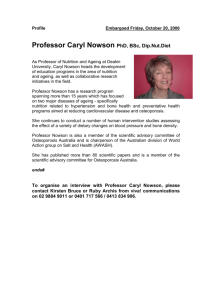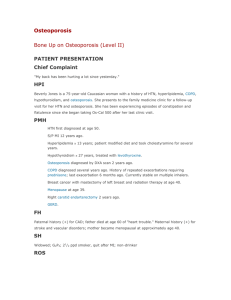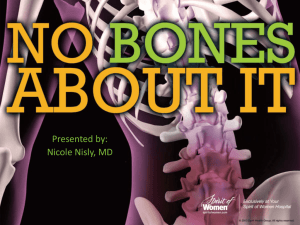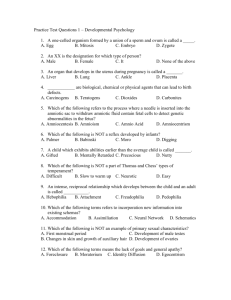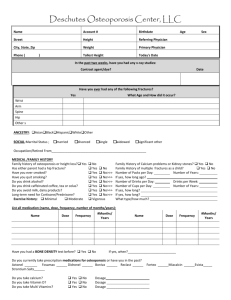The Relationship Between Osteoporosis Knowledge, Beliefs, and
advertisement
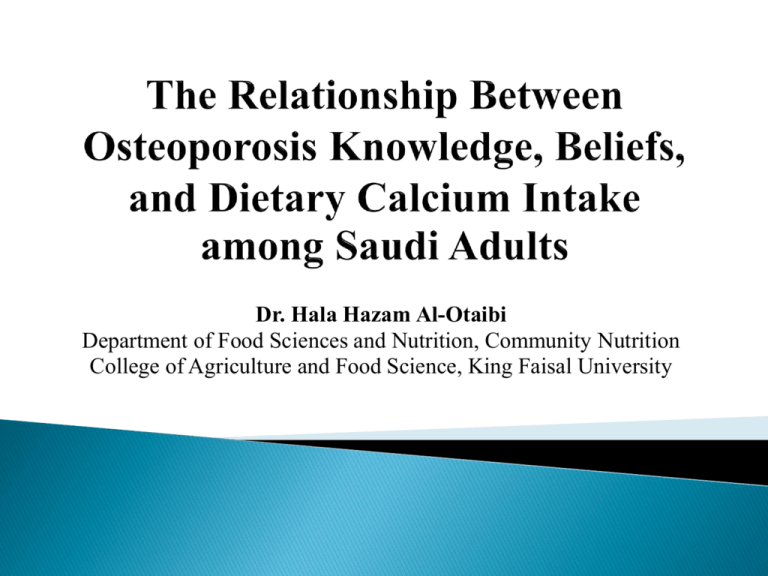
Dr. Hala Hazam Al-Otaibi Department of Food Sciences and Nutrition, Community Nutrition College of Agriculture and Food Science, King Faisal University Osteoporosis is a disease characterized by decreased bone density and loss of bone micro architecture quality which in turn lead to an increased risk of fracture. (WHO,2003) It was also reported as the fourth main enemy of the human after heart failure, stroke and cancer, and the most common cause of fractures in the world (WHO,2003). The present population in Saudi Arabia is estimated to be 25.7 million, of this 10% (2.5 million) is 50 years of age or over and 2% (450 000) is 70 or over. By 2050, it is estimated that 31% (12.3 million) of the population will be 50 or over and 8% (3.2 million) will be 70 or over while the total population will increase to 40 million. A systematic review for 36 local published articles by Mir Sadat et al (2012) indicate that the prevalence of low bone mass (osteoporosis and osteopenia) in Saudi Arabia is 70.5% in men and women with an average age of 56 years. The prevalence of osteoporosis among women 34% and in men 30.7%. Osteoporosis on increase due to the changes in lifestyle and diet habits of Saudis to be more westernized. It is preventable disease when we identifying factors affecting diet and lifestyle behavior change, then we can make changes easier to maintain bone mass and strength in young people and adults. Also awareness about the disease can helps in prevention. Using theories and models helps researchers to understand the dietary and life style behavior of people. One of the more popular models effective in health education and promotion is the Health Belief Model (HBM). Based on HBM, people change their behavior when they understand that the disease is serious otherwise they might not turn to healthy behaviors. (Edmonds etal,2012; Barzanji etal,2013; Jeihooni etal,2014). The present study aimed to determine osteoporosis knowledge, health believes and calcium intake among Saudi adults. To assess the HBM constructs and their relationship to calcium intake. Study design A descriptive web-based survey. Study population Subjects were invited to participate in a web-based survey by email letter. The letter was sent to an initial group of 46 adults known to the researcher, inviting them to: 1. Participate in the study. 2. Send the letter this to any other adults who fulfilled the criteria. The eligibility recruitment to participate in this study Saudi. Aged 20-60 years. Disease free. Not pregnant. The web-based questionnaire was included: Demographic and socioeconomic information. Anthropometric measurements:- Height, weight. Exercises habits 30 minutes/day (less than three times/week, more than three times/week) . Smoking habits (yes, no). Family history of osteoporosis (yes, no). Osteoporosis Health Belief Scale (OHBS). The OHBS developed by Kim etal, (1991) is a 42-item instrument consisting of seven subscales addressing health beliefs. The subscales address: 1. Susceptibility. 2. Severity. 3. Benefits to exercise. 4. Benefits to calcium intake. 5. Barriers to exercise, 6. Barriers to calcium intake, 7. Health motivation. Each item was rated using a5 point Likert scale: 1 = strongly disagree. 2 = disagree. 3 = neutral. 4 = agree. 5 = strongly agree. Possible range of 42 to 210 for the total health belief score. A possible range of 6 to 30 for each subscale score. Osteoporosis Knowledge Assessment Test (OKAT) The OKAT was developed by Winzwnberg etal. (2003). It is a 20-item question with statements that can answered with true, false, I don't know. The instrument consisting of 4 subscales addressing: 1. 2. 3. 4. Understanding (symptoms and risk of fracture) 5 items. Knowledge risk factors of osteoporosis 7 items. Knowledge of prevention factors as physical activity and diet relating to osteoporosis 6 items. Treatment availability 2 items. Food Frequency Questionnaire related to calcium rich foods intake include 30 items based on MOH. Each item is rated as: never or rarely. one times per week. 2-3per week. 4-5 per week. Every day. Frequency, mean and standard deviation. Chi-square test. The independent T-test. Pearson's correlation coefficient. The significance level was set at 0.05. SPSS 19.0 . The overall reliability of the instrument based on Cronbach's alpha was 0.87. Variable Age Mean (s.d) Education level Secondary and lower University and higher Employment status Employed Not employed Marital status Single Married Family history of osteoporosis yes No Income (Saudi Real) <5000 >5000 *P<0.05, **P<0.001 Male (285) 33.84+9.8 Female (287) 32.51+8.1 P 125 (43.8%) 160 (56.2%) 71(24.6%) 216 (75.4%) 0.00** 224 (78.9%) 39 (21.1%) 213 (74.3%) 74 (25.7%) 0.00** 103 (36.2%) 182 (63.8%) 112 (39%) 175 (61%) 0.57 74 (39.5%) 212 (74.1%) 100 (34.8%) 187 (65.2%) 0.06 124 (43.8%) 161 (56.2%) 184 (64.2%) 103 (35.8%) 0.00** 0.00** Variable Male (285) Female (287) P BMI (kg/m2), Mean (s.d) 24.8+4.5 23.6+5.3 0.018* < 18.5 15 (4.9%) 39 (14.4%) 0.00** 18.5 - 24.9 153 (47.6%) 162 (56.7%) 25 – 29.9 153 (47.6%) 86 (29.9%) <3 times/week 148 (51.9%) 126 (67.4%) >3 times/week 137 (48.1%) 161 (32.6%) yes 104 (36.8%) 13 (4.3%) No 181 (63.2%) 274 (95.7%) Calcium rich foods intake Serving /day 1.8+0.04 2.8+0.04 Exercises 0.003* Smoking *P<0.05, **P<0.001 0.00** 0.00** Variable Male (285) Female (287) P Knowledge ( 20 items) 8.7+2.6 9.4+2.7 0.011* Perceived Susceptibility (Q1 - 6) 16.5+4.9 17.7+5.1 0.02* Perceived Severity (Q7 - 12) 14.5+4.9 15.8+4.9 0.008* Perceived Benefits of exercises (Q13-18) 22.03+5.01 21.5+4.2 0.35 Perceived Benefits of calcium intake (Q19-24) 22.5+4.6 22.4+4.1 0.77 Perceived Barriers of exercises (Q25-30) 15.7+4.5 16.9+4.1 0.009* Perceived Barriers of calcium intake (Q31-36) 16.3+4.1 16.5+3.3 0.62 Motivation(Q37-42) 21.1+5 20.8+4.5 0.55 OHBM items (Q1-42) 128.9+17.08 132.06+13.9 0.056 *P<0.05, Results showed a direct relationship between calcium intake and perceived susceptibility (r=0.161, p=0.05). perceived severity (r=0.192, p=0.01). But it has a significant inverse relationship with perceived barriers to exercise (r=-0.184, p=0.05). The total osteoporosis knowledge score was lower than expected in this group of well-educated subjects. Studies utilizing the OKAT or similar instruments and have similar mine aged (30- 40) have also reported poor to moderate levels of knowledge (Edmonds etal,2012; Barzanji etal,2013; Jeihooni etal,2014). Usually younger subjects not aware about osteoporosis as 50s and above (Johnson etal,2008). National Osteoporosis Awareness Campaign 2006, 2012 Female are perceived to be more susceptibility and severity toward osteoporosis than male with significant difference between them, that could be du to misperception that osteoporosis is a disease effects only female. According to the HBM, they will not take preventative measures to ward off the disease, in other words; They did not believe that osteoporosis would significantly affect their lives. The study subjects had positive views (benefits) of both exercises and calcium intake, while they reported few barriers for calcium intake . They consumed adequate amounts of calcium rich foods almost 2 servings for male and about 3 servings for female. Barrier of exercises among women was high, only 32.3% exercises more than 90 minutes in a week. In Saudi Arabia, as many Middle East countries, females have lower participation in any physical activity Traditional role of homemaker if they are married, and helping other women in their family if they are not married (mother, sister, grandmother, etc.). Literature review by Mcleod etal,(2011) introduces motivation as an effective and important factors that improves behavior to prevent osteoporosis. The subjects had a high level of health motivation to prevent osteoporosis. That can helped them to create change and maintain appropriate behavior (Edmonds etal,2012). Calcium intake had a significant relationship with the female perceived susceptibility and severity. They felt susceptible to osteoporosis. In this study, there was an inverse association between calcium intake and perceived barriers of exercise. That could be they believe consume more rich calcium foods there is no need to be active. The subjects in this study were not representative all Saudi adults aged 20–55 years. This was a sample of adults who reported high levels of education. Recruitment was self-selecting. The number of subjects who were invited to participate and the number of subjects who declined to participate were not ascertained. (Response Rate) This study reveals lack of knowledge about osteoporosis prevention. Majority of subjects not physically active especially female. Revealed important relationship between susceptibility and severity toward osteoporosis among women. Without knowledge, behavior change is not informed, and individuals must be aware of osteoporosis before they can be expected to take preventive steps. World Health Organization (2003) The burden of musculoskeletal conditions at the start of the new millennium, WHO Technical Report Series 919, World Health Organization,Geneva. National Osteoporosis Foundation (2008) National Osteoporosis Foundation— Osteoporosis facts. http://www.nof.org/osteoporosis/diseasefacts.htm#cost Mir Sadat-Ali, Ibrahim M. Al-Habdan, Haifa A Al-Turki, Mohammed Quamar Azama. An epidemiological analysis of the incidence of osteoporosis and osteoporosis-related fractures among the Saudi Arabian population. Ann Saudi Med 2012; 32(6): 637-641 Sarah, L. and M.D. Morgan, 2001. Calcium and vitamin D in osteoporosis. Rheumatic Disease Clinics of North America, 27: 101-30. National Osteoporosis Foundation: Clinician’s Guide to prevention and treatment of osteoporosis. Washington, DC: National Osteoporosis Foundation; 2010. Accessed at www.nof.org/sites/default/files/./NOF_ClinicianGuide2009_v7.pdf. Kim KK, Horan ML, Gendler P, Patel MK: Development and evaluation of the osteoporosis health belief scale. Res Nurs Health 1991, 14:155–163. Winzenberg TM, Oldenburg B, Frendin S, Jones G: The design of a valid and reliable questionnaire to measure osteoporosis knowledge in women: the osteoporosis knowledge assessment tool (OKAT). BMC Musculoskelet Disord 2003, 4:17. Sizer, F. and Whitney, E. (2008) Nutrition: Concepts and controversies. 11th Edition, Thompson-Wadsworth, Belmont. Ministry of Health. National Osteoporosis Awareness Campaign http://www.moh.gov.sa/en/HealthAwareness/Campaigns/hashasha/Pages/010.aspx Edmonds,E, Lori, W. Turner and L. Stuart, 2012 Usdan, Osteoporosis knowledge, beliefs and calcium intake of college students: Utilization of the health belief model. Open Journal of Preventive Medicine 2..34-27 :)1(

